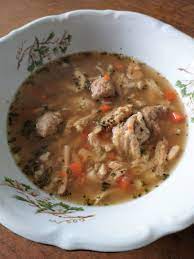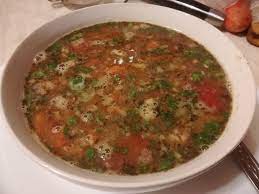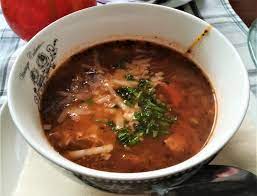During my journey to Sweden, I received a fervent recommendation from locals to try a traditional Polish dish called Flaki. Described as an affordable and hearty option, it piqued my curiosity. With no prior knowledge of this intriguing dish, I was eager to embark on this culinary adventure. As I approached my first Flaki vendor, I was about to experience a revelation of flavors and textures that would leave a lasting impression. Upon my first taste of Flaki, I encountered a delightful surprise. The dish boasted a spiciness that immediately tantalized my taste buds. However, it was the unique combination of textures and distinctive aroma that truly set it apart. It became evident that Flaki was an acquired taste, offering an experience that challenged conventional palates.
History and Tradition
Flaki, an emblem of Polish culinary heritage, showcases the country’s resourceful approach to cooking. It is crafted from tripe, the stomach lining of beef, which is carefully cleaned and then slow-cooked to achieve a tender and hearty dish. Throughout the cooking process, the tripe absorbs a blend of aromatic vegetables, spices, and broth, resulting in a complex and savory flavor profile. This traditional delicacy, born out of necessity in rural Poland, has evolved into a cherished dish, becoming an integral part of festive gatherings and family celebrations, thus underscoring its cultural significance.


To prepare Flaki, culinary expertise and patience are essential. The tripe, sourced from beef, undergoes a meticulous cleaning process to ensure its purity. It is then subjected to a thorough simmering, a process that transforms its initially tough texture into a succulent delight. The gradual infusion of flavors during slow-cooking yields a dish that boasts both robustness and harmonious seasoning. This careful technique exemplifies the artistry behind crafting this celebrated Polish delicacy.
Culinary Technique
Crafting Flaki is a culinary endeavor that demands precision and a discerning palate. It entails the artful blending of an array of spices, aromatic vegetables, and a nourishing broth. The infusion of ingredients like onions, carrots, celery, and an assortment of herbs adds depth and complexity to the flavor profile. These components work in concert to elevate the inherent taste of the tripe, imbuing it with a luxurious, savory essence. Through the patient process of slow simmering, the flavors meld seamlessly, culminating in a symphony of tastes that distinctly characterize Flaki. This meticulous approach underscores the culinary mastery required to perfect this cherished Polish dish.
Acquiring a Taste
Admittedly, the initial encounter with Flaki may not be love at first bite for everyone. Its distinctive texture and aroma can be an acquired taste, requiring an open-minded approach to truly appreciate its nuances. The pivotal factor in this culinary adventure lies in the meticulous preparation of the tripe, a step where precision reigns supreme. If not cleaned with the utmost care, an unpleasant odor and taste can mar the otherwise delightful experience. However, in the skilled hands of a seasoned chef or a trusted local expert, Flaki transforms into a savory masterpiece.
In the quest for the quintessential Flaki, seasoned travelers and discerning diners know that locals hold the key. They are the keepers of time-honored techniques and treasured family recipes. These culinary aficionados understand that the true artistry of Flaki hinges on the thorough cleaning of the tripe. They look for the telltale signs of expertise: the distinctive long lines that denote an unwavering dedication to preparation. Following the lead of these seasoned locals guarantees an authentic Flaki experience, where the dish’s genuine flavors shine through, and any lingering aftertastes are skillfully avoided.
The addition of bold spiciness further heightens the Flaki adventure, injecting an element of excitement for those in search of a gastronomic thrill. This zesty kick harmonizes beautifully with the earthy richness of the tripe, creating a symphony of flavors that distinguishes Flaki as a uniquely Polish culinary gem. It is a dish that rewards the curious palate, inviting diners to revel in the artistry and complexity that define this beloved tradition.Whether you’re following the longest lines or seeking the sage advice of local connoisseurs, embracing the world of Flaki promises a culinary journey like no other.
Want to make it yourself? Sure!
To prepare Flaki at home, begin by thoroughly cleaning 500g of beef tripe, ensuring any impurities are removed. Soak it in water with a bit of vinegar to aid in the cleaning process, then rinse well and cut it into strips. In a large pot, heat 2 tablespoons of vegetable oil over medium heat. Add a finely chopped onion, 2 peeled and finely chopped carrots, and 2 finely chopped celery stalks. Sauté these ingredients until the vegetables are softened and the onion turns translucent. Introduce 2 minced garlic cloves, along with a bay leaf, 1 teaspoon each of dried marjoram and dried thyme, 1 teaspoon of paprika, 1/2 teaspoon of black pepper, and a pinch of salt. Stir the mixture well to combine, allowing the fragrant aromatics to meld for about a minute.

Next, incorporate the cleaned tripe into the pot and pour in 1 liter of beef broth. Bring the mixture to a gentle boil. Reduce the heat to low, cover the pot, and allow it to simmer for approximately 2 to 2.5 hours, or until the tripe achieves a tender texture. Keep an eye on the liquid level and add more broth if needed to maintain a desired consistency. Once the Flaki is cooked to perfection, taste and adjust the seasoning with additional salt or spices, if desired. Remove and discard the bay leaf, then serve the Flaki hot, garnishing it with chopped fresh parsley for a finishing touch. Optionally, you can enhance the dish by adding vegetables like potatoes or tomatoes for extra flavor and texture. Another variation involves incorporating tomato paste for a richer, tangier profile. Consider serving it with a dollop of sour cream and a side of crusty bread for a complete and hearty meal. Enjoy the authentic flavors of this cherished Polish dish prepared in the comfort of your own home!
Flaki is more than just a dish; it is a journey into the heart of Polish culinary culture. The initial surprise gives way to a nuanced appreciation for its unique blend of flavors, textures, and aromas. This traditional delicacy exemplifies the art of transforming humble ingredients into a truly extraordinary experience. For those embarking on a culinary adventure through Poland, trying Flaki is an essential step towards understanding and appreciating the country’s rich gastronomic heritage. Beyond its intricate flavors, Flaki offers an additional allure – affordability. It stands as a testament to Poland’s culinary tradition of providing filling, nourishing meals that will not break the bank. For travelers seeking an authentic taste of Poland without straining their budget, Flaki emerges as a perfect choice.






